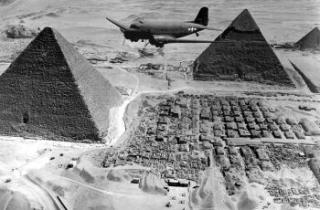
Exploring the history and experiences of mixed heritage persons and inter-racial relationships across the world

Exploring the history and experiences of mixed heritage persons and inter-racial relationships across the world
World War II heralded a marked shift in human history apart from the fighting itself. It was responsible for the eventual formalising of a form of migration - refugees - and it marked the beginning of the end of the second period of colonialism.
 After the war, Europe had over 40 million refugees or as they were called then 'displaced persons'. The United Nations Relief and Rehabilitation Administration was set up in 1943, to provide humanitarian relief and to aid repatriation but this was in a different world from what was before the war. Many, many people were forced to migrate even into circumstances that were to their detriment; for example, many Russian refugees and Prisoners of War were treated as traitors on their repatriation back to Russia. People who had changed citizenship many years before the war found themselves being transported to places of origin that they had left decades ago. Some 2 million people are estimated to have died during these forced migrations. (see http://en.wikipedia.org/wiki/War_refugee#World_War_II_and_UNHCR for more horrific details.)
After the war, Europe had over 40 million refugees or as they were called then 'displaced persons'. The United Nations Relief and Rehabilitation Administration was set up in 1943, to provide humanitarian relief and to aid repatriation but this was in a different world from what was before the war. Many, many people were forced to migrate even into circumstances that were to their detriment; for example, many Russian refugees and Prisoners of War were treated as traitors on their repatriation back to Russia. People who had changed citizenship many years before the war found themselves being transported to places of origin that they had left decades ago. Some 2 million people are estimated to have died during these forced migrations. (see http://en.wikipedia.org/wiki/War_refugee#World_War_II_and_UNHCR for more horrific details.)
Europe was not the only place where forced migration happened, between 1941 to 1949 an estimated 120,000 Japanese Americans and Japanese residing in the United States were forcibly interned in ten different camps across the US. These people had to resettle themselves after the war. The Japanese defeat in the Far East meant that thousands of Japanese were expelled from places like Manchuria, Korea and Taiwan.
The creation of the Soviet Union created another set of immigrants running away from what they viewed as an oppressive and dangerous regime. Some of them settled in Britain, particularly Poles and Ukrainians. In the 1951 census, the Polish-born population of the UK numbered some 162,339 up four fold from 1931. Following the crushing of the 1956 Hungarian revolution, over 20,000 Hungarians came to Britain.
The International Refugee Organization (IRO) was formed in in 1947 and evolved into United Nations High Commissioner for Refugees (UNHCR) in 1950. The formalisation of refugee status plays a major role in the post war immigration that continues to this day.
After the war, many colonies especially British ones, sought to encourage immigration. Australia implemented many strategies taking up many refugees via the International Refugee Organization who sponsored over 180,000 people. The 'Bring A Briton' campaign and the 'Ten Pound Poms' assisted packages revealed the Australians bias to encouraging white, preferably British, immigration but they also received many non-English speaking people. South Africa, the Federation of Rhodesia and Nyasaland also sought to attract mainly working class ex-servicemen where for example the economic boom in Southern Rhodesia prompted the immigration of about 200,000 white settlers between 1945 and 1970, taking the white population up to 270,000. Kenya, on the other hand, attempted to attract upper class ex-officers. This period stands out in sharp contrast to today's Governments' positions on economic, which this was, immigration.
 The brakes on mainly European immigration to the colonies came from the wave of post war independence movements. Wave after wave of countries, many of them, non-settler colonies became independent. For the settler colonies the writing was on the wall and immigration reduced as it became obvious that the benefits of immigration were in danger of being erased and these counties descended into civil/independence wars. South Africa and Rhodesia (Zimbabwe) held out for some time but as in Rhodesia during the independence war, more Europeans left than arrived. After independence, settler colonies lost a significant number of European origin citizens.
The brakes on mainly European immigration to the colonies came from the wave of post war independence movements. Wave after wave of countries, many of them, non-settler colonies became independent. For the settler colonies the writing was on the wall and immigration reduced as it became obvious that the benefits of immigration were in danger of being erased and these counties descended into civil/independence wars. South Africa and Rhodesia (Zimbabwe) held out for some time but as in Rhodesia during the independence war, more Europeans left than arrived. After independence, settler colonies lost a significant number of European origin citizens.
The European descendants though were not the only ones immigrating out of Africa, so were many native Africans as Asylum seekers (the term used before one is recognised as a refugee) as country after country, mainly in Africa, descended into civil war or dictatorship. Many of these refugees turned to the colonising country for sanctuary. Internally displaced people and those who just slipped over the border sometimes into even worse circumstances increased over this period as well. See http://en.wikipedia.org/wiki/War_refugee for more information.
Asylum seeking and economic migration now plays a major role in immigration in many of the previous colonising powers much to the chagrin of the local working class population whose benefit from empires was limited or non-existent. Many of the immigrant families are now second or even third generation and contribute immensely to the multiculturalism that exists in many of these countries.
This post serves mainly as a useful pre-cursor to the articles on immigration and multiculturalism.